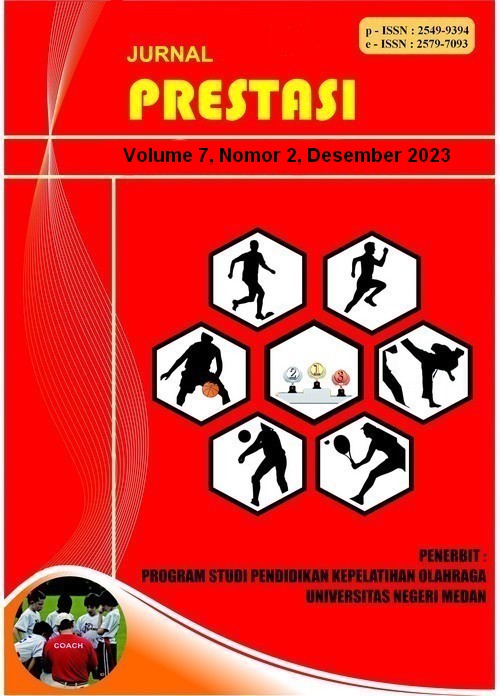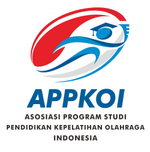PERBEDAAN PENGARUH METODE PEMBELAJARAN DAN KECEPATAN REAKSI TERHADAP HASIL BELAJAR SEPAK SILA MAHASISWI PKO FIK UNIMED
DOI:
https://doi.org/10.24114/jp.v7i2.53284Keywords:
Sepak Sila, Metode Pembelajaran, Kecepatan ReaksiAbstract
Tujuan dari penelitian ini adalah untuk mengetahui (l) Perbedaan pengaruh metode pembelajaran bola rotan dan bola kenchi terhadap hasil belajar sepaksila (2) Perbedaan pengaruh kecepatan reaksi tinggi dan kecepatan reaksi rendah terhadap hasil belajar sepaksila (3) Mengetahui interaksi antara kecepatan reaksi dengan hasil belajar sepak sila. Penelitian menggunakan metode eksperimen dengan desain penelitian faktorial 2 x 2. Populasi penelitian ini adalah seluruh mahasiswa PKO FIK Unimed yang mengambil mata kuliah sepak takraw tingkat lanjut yang berjumlah 50 orang. Sampel sebanyak 30 orang, diambil dengan teknik purposive sampling. Instrumen penelitian menggunakan tes kecepatan reaksi dan tes sepaksila. Teknik analisis data menggunakan analisis statistik, sedangkan perhitungannya menggunakan uji beda dengan ukuran 2 x 2. percobaan ANOVA faktorial pada taraf signifikan 5%. Untuk memenuhi asumsi hasil penelitian maka dilakukan uji reliabilitas dan uji prasyarat analitis. Hasil penelitian menunjukkan (1). Terdapat perbedaan pengaruh metode pembelajaran antara bola rotan dan bola kenchi terhadap hasil belajar sepaksila. (thitung > ttabel) 4,900 > 2,048. (2). Terdapat perbedaan pengaruh kecepatan reaksi tinggi dan kecepatan reaksi rendah terhadap hasil belajar sepaksila (thitung > ttabel) 6.991 > 2,048). (3). Terdapat interaksi antara kecepatan reaksi terhadap hasil belajar sepaksila. Nilai Adjusted R Square sebesar 0,661 artinya terdapat interaksi sebesar 66,1%.References
Aziz Hakim. A. (2007). Sepak Takraw, Semarang: Unesa Universiy Press
Chen, S,. Dai. H. Tang. J,. and Xiao. R. (2018). Physiological Profile of Sepaktakraw University Players. 63-66. http:/doi.org/10264080/icecsd.01.2018.63.66
Gani, A. (2018). The Development of Sepak takraw Skill Training Model Based on Drill Double Event in South Jakarta Club Takraw. Journal of Education, Health and Sport, 8(12), 303“316.
Hananto. H.P & Hari A.R. (2013). Keterampilan Bermain Sepaktakraw Pelajar DIY. Jurnal Keolahragaan, 1(2). 142-155. https://doi.org/10.21831/jk.v1i2.2570
Jewis M.N. Singh. H.,& Yassin. (2015). Anthropometric and Physiological profiles of Sepaktakraw Players. British Journal Sport Medicine 39(11), 825-829. http:/doi.org. 10.1136.bjsm.2004
Rusli Lutan. (1994). Strategi Pembelajaran Pendidikan Jasmani dan Kesehatan Jakarta: Direktorat Jenderal Pendidikan Dasar dan Menengah.
Zainuddin. H. (2012). Sepak Takraw, Sejarah, Teknik Dasar Permaian & Peraturan Sepak Takraw. Jakarta: Aulia Cendekia Press
Downloads
Published
Issue
Section
License
Copyright (c) 2023 JURNAL PRESTASI

This work is licensed under a Creative Commons Attribution 4.0 International License.
Authors who publish with this journal agree to the following terms:
- Authors retain copyright and grant the journal right of first publication with the work simultaneously licensed under a Creative Commons Attribution License that allows others to share the work with an acknowledgment of the work's authorship and initial publication in this journal.
- Authors are able to enter into separate, additional contractual arrangements for the non-exclusive distribution of the journal's published version of the work (e.g., post it to an institutional repository or publish it in a book), with an acknowledgment of its initial publication in this journal.
- Authors are permitted and encouraged to post their work online (e.g., in institutional repositories or on their website) prior to and during the submission process, as it can lead to productive exchanges, as well as earlier and greater citation of published work (See The Effect of Open Access).
- This work is licensed under a Creative Commons Attribution-ShareAlike 4.0 International License.





















